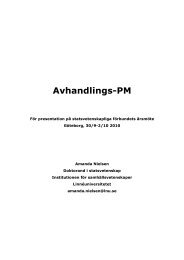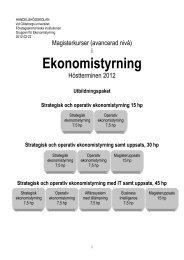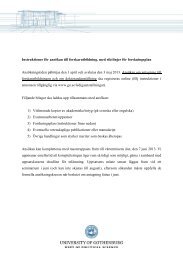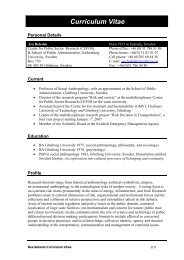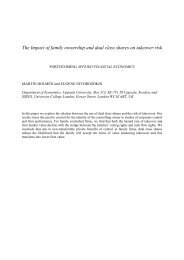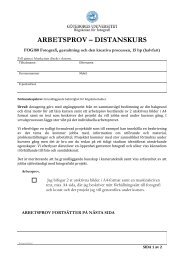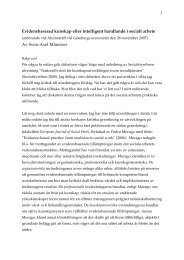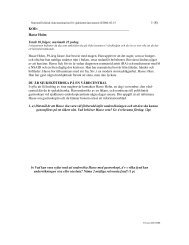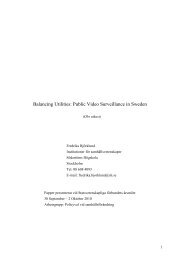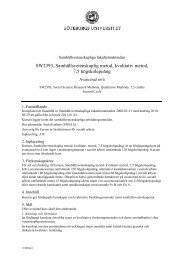Quality of Government Makes People Happy
Quality of Government Makes People Happy
Quality of Government Makes People Happy
Create successful ePaper yourself
Turn your PDF publications into a flip-book with our unique Google optimized e-Paper software.
=<br />
=<br />
=<br />
=<br />
=<br />
=<br />
<strong>Quality</strong> <strong>of</strong> <strong>Government</strong> <strong>Makes</strong> <strong>People</strong> <strong>Happy</strong><br />
Marcus Samanni<br />
Sören Holmberg<br />
=<br />
=<br />
=<br />
=<br />
=<br />
=<br />
=<br />
=<br />
=<br />
=<br />
=<br />
QoG WORKING PAPER SERIES 2010:1=<br />
=<br />
THE QUALITY OF GOVERNMENT INSTITUTE<br />
Department <strong>of</strong> Political Science<br />
University <strong>of</strong> Gothenburg<br />
Box 711<br />
SE 405 30 GÖTEBORG<br />
March 2010<br />
ISSN 1653-8919<br />
© 2010 by Marcus Samanni and Sören Holmberg. All rights reserved.
<strong>Quality</strong> <strong>of</strong> <strong>Government</strong><br />
<strong>Makes</strong> <strong>People</strong> <strong>Happy</strong><br />
Marcus Samanni<br />
Sören Holmberg<br />
QoG Working Paper Series 2010:1<br />
March 2010<br />
ISSN 1653-8919<br />
Marcus Samanni<br />
The <strong>Quality</strong> <strong>of</strong> <strong>Government</strong> Institute,<br />
Department <strong>of</strong> Political Science<br />
University <strong>of</strong> Gothenburg<br />
marcus.samanni@pol.gu.se<br />
Sören Holmberg<br />
The <strong>Quality</strong> <strong>of</strong> <strong>Government</strong> Institute,<br />
Department <strong>of</strong> Political Science<br />
University <strong>of</strong> Gothenburg<br />
soren.holmberg@pol.gu.se
The hypothesis in this paper may seem a little strange, especially to neo-liberal<br />
economists. We will test whether government could be part <strong>of</strong> the solution and not part <strong>of</strong><br />
the problem as is so <strong>of</strong>ten the case in some economic theories. Our hypothesis is that<br />
quality <strong>of</strong> government – defined as effectiveness, impartiality, rule <strong>of</strong> law and no<br />
corruption – is a factor, a prerequisite, behind aggregate levels <strong>of</strong> feelings <strong>of</strong> happiness<br />
and satisfaction with life among populations across the Earth. <strong>Quality</strong> <strong>of</strong> government<br />
makes people happy. And it makes people happy in rich countries as well as in poor<br />
countries. Maybe not Big <strong>Government</strong>, but certainly Good <strong>Government</strong>, is an essential<br />
recipe for making citizens more content with their lives. That is our strange hypothesis.<br />
Earlier Research on <strong>Quality</strong> <strong>of</strong> <strong>Government</strong> and Happiness<br />
Earlier research on the relationship between quality <strong>of</strong> government and happiness is not<br />
abundant. What there is, however, indicates that, on a general level, <strong>Quality</strong> <strong>of</strong><br />
<strong>Government</strong> (QoG) has a positive effect on happiness. The more effective, incorrupt and<br />
impartial government institutions, the happier and the more satisfied with their lives are<br />
the citizens (Bjørnskov et al 2008; Helliwell and Huang 2008; Ott 2005).<br />
A central feature in the literature is if there is an interaction <strong>of</strong> QoG with economic<br />
development. It is sometimes argued that QoG only has an effect in poor countries. In<br />
models with only richer countries the QoG variable <strong>of</strong>ten, but not always, fails to reach<br />
significance.<br />
Helliwell and Huang (2008) analyze 75 countries and in the full sample QoG has a<br />
significant and positive effect on subjective well-being. However, when dividing the<br />
sample into countries that have below and those that have above half <strong>of</strong> the GDP <strong>of</strong> the<br />
United States, QoG is significant only in the group <strong>of</strong> poorer countries. A possible<br />
explanation <strong>of</strong> this could be that QoG increases happiness through economic growth, and<br />
that economic growth does not have any effect on happiness when economic wealth has<br />
reached above a certain level (Blanchflower and Oswald 2004; Layard 2005). 1 However<br />
when controlling for GDP, the coefficient <strong>of</strong> the QoG variable declines by only 10-20<br />
1 That economic wealth does not contribute to greater happiness above a certain level is contested by<br />
Hagerty and Veenhoven (2003) and Stevenson and Wolfers (2008).<br />
2
percent, so that it cannot be that QoG only “contributes to well-being by producing higher<br />
per capita incomes.” (Helliwell and Huang 2008, p. 603)<br />
Similar results is reached by Bjørnskov et al (2008). In their full sample <strong>of</strong> both rich and<br />
poor countries, the QoG variable is significantly connected with greater happiness in all<br />
their different models. However, when dividing their sample into countries above and<br />
below a GDP per capita <strong>of</strong> 8000 USD, the QoG variable again loses its significance in the<br />
group <strong>of</strong> richer countries when one <strong>of</strong> their two different operationalizations <strong>of</strong> happiness<br />
is used. One could argue, though, that Bjørnskov et al (2008) put the QoG variable to a<br />
test that is too hard. They include interpersonal trust in their models and there is reason to<br />
believe that interpersonal trust could be one <strong>of</strong> the mechanisms through which QoG<br />
produces greater subjective well-being. Incorrupt and effective governmental institutions<br />
have been shown to produce trust between citizens (Rothstein 2003; Rothstein and Stolle<br />
2003), and there is evidence that interpersonal trust increases happiness (Diener and Suh<br />
1999; Helliwell and Huang 2008). Including interpersonal trust in the model might then<br />
lead to an underestimation <strong>of</strong> the effect <strong>of</strong> QoG.<br />
That interpersonal trust is one <strong>of</strong> the mechanisms through which QoG increases<br />
happiness is exactly what is found by Teorell (2009). First he finds that QoG has a<br />
significant effect on happiness. This is the case both when he is using Teorell’s (2009)<br />
original measure <strong>of</strong> QoG as impartiality <strong>of</strong> government institutions, and when using<br />
governance indicators from the World Bank. Second, he also finds a few mechanisms for<br />
this effect: interpersonal trust, economic growth and the low propensity for civil war are<br />
all linked to QoG. And when introducing these three variables as controls in the model <strong>of</strong><br />
subjective well-being, the QoG effect is no longer significant when using the impartiality<br />
measure (p. 20). When using the different World Bank operationalizations <strong>of</strong> QoG the<br />
effect is significant even when controlling for growth, trust and civil war, but is<br />
weakened. Teorell does not analyze poor and rich countries separately. His sample<br />
consists <strong>of</strong> 52 countries, with a slight overweight <strong>of</strong> countries from the OECD<br />
Finally, Samanni (2009) does a time-series cross-section analysis <strong>of</strong> twelve West<br />
European countries. In one <strong>of</strong> his models QoG has a significant and positive effect on<br />
3
happiness, but it fails to reach significance in a harder test (with a lagged dependent<br />
variable).<br />
In sum, earlier research shows a clear connection between QoG and happiness in poorer<br />
countries. In richer countries the results are mixed, sometimes indicating a positive effect<br />
on happiness, but <strong>of</strong>ten not. Thus, whether QoG is good for happiness also in more<br />
affluent countries is still an open question. One <strong>of</strong> the goals <strong>of</strong> this paper is to try to close<br />
that question.<br />
Other Variables Affecting Happiness<br />
Among other variables that have been shown to have an effect on subjective well-being,<br />
GDP per capita is <strong>of</strong> course one. Being poor is bad for happiness. Whether higher GDP<br />
has any effect above a certain level is, as mentioned earlier, not entirely clear. Some<br />
claim that the rich part <strong>of</strong> the world has not seen an increase in happiness in the last few<br />
decades although GDP has risen considerably (Easterlin 1974; Layard 2005;<br />
Blanchflower and Oswald 2004). Others claim that we indeed have seen an increase in<br />
happiness when GDP rises, even in the rich part <strong>of</strong> the world (Hagerty and Veenhoven<br />
2003; Stevenson and Wolfers 2008). It therefore seems reasonable to include GDP as a<br />
control variable in the analysis.<br />
Another important factor stressed in the literature is individualism. The more<br />
individualistic the culture <strong>of</strong> a country is, the happier are the citizens. In individualistic<br />
countries people are in a higher degree free from social constraints and can choose their<br />
own lifestyle, resulting in greater happiness (Ahuvia 2002; Brülde 2007, p 149; Diener<br />
and Suh 1999). We don’t have any direct measure <strong>of</strong> individualism. Instead we use a<br />
measure <strong>of</strong> post-material values from the World Values Survey as a proxy for<br />
individualistic culture.<br />
Religion has been shown to have an effect on life satisfaction both on the micro and the<br />
macro level. Religious persons have higher subjective well-being than non-religious<br />
persons, and the more religious the population the higher average subjective well-being in<br />
a country (Argyle 2001; Brülde 2007, p 223; Helliwell and Huang 2008).<br />
4
Democracy is also conducive to happiness. When people are able to select their leaders,<br />
subjective well-being is higher (Dorn et al 2007; Helliwell and Huang 2008; Veenhoven<br />
1984).<br />
Health is another important factor behind the feeling <strong>of</strong> happiness. Countries where<br />
people live longer and are healthier do better in terms <strong>of</strong> subjective well-being. Health is<br />
also thought to be one <strong>of</strong> the mechanisms through which higher QoG leads to more<br />
happiness. Where QoG is higher the health care system works better, and people are<br />
healthier. This is at least the case for poorer countries (Helliwell and Huang 2008, p.<br />
611).<br />
Choice <strong>of</strong> Operational Variables<br />
We start with a basic benchmark looking at bivariate relationships between on the one<br />
hand happiness and life satisfaction as dependent variables and on the other hand a set <strong>of</strong><br />
independent explanatory variables that have been deemed important in the literature. The<br />
two dependent variables are subjective measures taken from the World Values Surveys<br />
indicating degrees <strong>of</strong> personal happiness and life satisfaction on self-placement scales.<br />
The two feel good variables are intended to capture two different theoretical constructs,<br />
but in practice the correlation between the two measures is quite high. It is +.73 for the<br />
ninety countries covered by WVS.<br />
Since the main purpose <strong>of</strong> our analysis is to test if, and to what extent, quality <strong>of</strong><br />
government matters for how happy and satisfied people are with their lives, we have<br />
included three different QoG variables in the study – the World Bank’s government<br />
effectiveness variable, Transparency International’s corruption perceptions index, and the<br />
<strong>Quality</strong> <strong>of</strong> <strong>Government</strong> Institute’s new government impartiality measure. The latter is<br />
based on expert judgments collected by the QoG Institute in about fifty countries around<br />
the world (Teorell 2009). In theoretical terms, the three indicators are meant to cover<br />
slightly different phenomena. However, in practice they are all very highly interrelated<br />
with correlations <strong>of</strong> around +.85 between them.<br />
5
As control variables we have brought along a long series <strong>of</strong> variables that are frequently<br />
present in the theoretical as well as in the empirical literature on happiness and life<br />
satisfaction. Since money always matters, three economic variables are included, one<br />
measuring degree <strong>of</strong> richness (GDP per capita) and two measuring economic equality<br />
(Gini index and Income share <strong>of</strong> poorest 20%). The latter variables are very important to<br />
study if we believe Wilkinson‘s and Pickett’s (2009) argument that degrees <strong>of</strong> societal<br />
equality have a pr<strong>of</strong>ound impact on most things in a modern society, including happiness.<br />
On the individual micro level, health is one <strong>of</strong> the strongest factor explaining people’s life<br />
satisfaction and happiness (Argyle 2001, Klein 2002, Holmberg and Weibull 2004,<br />
Hellevik 2008). In our aggregate level study we have included the two most <strong>of</strong>ten used<br />
health indicators – Healthy life expectancy and Infant mortality.<br />
To feel reasonably secure is one <strong>of</strong> many psychological prerequisites for feeling happy<br />
(Brülde 2009). Consequently, we thought it appropriate to try to include some variables<br />
related to security. Lacking good direct measures, we decided to include two rather crude<br />
proxy measures for the feeling <strong>of</strong> security. These are two trust variables – Interpersonal<br />
trust and as a proxy for societal trust, Confidence in parliament. The hypothesis being<br />
that if you do not trust your fellow man and the important institutions in the society<br />
where you live it is difficult to be satisfied with your life or to be happy. The operating<br />
mechanism behind is <strong>of</strong> course the feeling <strong>of</strong> security. If you do not feel safe among<br />
people and in the society where you live, life satisfaction and happiness will be elusive.<br />
Two somewhat contradicting variables <strong>of</strong>ten found as explanatory variables in the<br />
happiness literature are religiosity and post-materialism. They are contradicting in the<br />
sense that the variables tend to be negatively correlated. Religious people tend not to be<br />
high on post-materialism. But when it comes to happiness and life satisfaction both<br />
variables have a positive relation. Religious people as well as post-materialists tend to be<br />
more satisfied with their lives and to be more happy than the average person. The two<br />
variables that we have included in our analysis are both taken from the World Values<br />
Surveys. They are Importance <strong>of</strong> God and Inglehart’s Post-Materialism scale.<br />
6
Last, and very obviously, we have included a variable measuring Level <strong>of</strong> Democracy in<br />
the ninety countries selected for our study. It is not believable to talk about independent<br />
effects <strong>of</strong> quality <strong>of</strong> government without controlling for degrees <strong>of</strong> democracy<br />
(Veenhoven 1984). The control is necessary since the two variables are highly<br />
interconnected with correlations around +. 55. Our chosen democracy measure is taken<br />
from Freedom House’s annual studies combined with Polity’s index. A problem with it is<br />
that the variance is very limited among Western countries. They all tend to have the<br />
highest score possible<br />
Looking at Fundamental Relationships<br />
The fundamental relationships between our dependent and independent variables are<br />
published in a special Figure Appendix. There 16 bivariate scatter plots with regression<br />
lines are printed with the life satisfaction variable systematically running against a sample<br />
<strong>of</strong> our chosen independent variables. The happiness variable proves to have a poor face<br />
validity and weaker relationships with most explanatory variables, hence it is only<br />
included in a limited number <strong>of</strong> scatter plots.<br />
Our three QoG variables reveal very similar outcomes, therefore we have restricted the<br />
number <strong>of</strong> scatter plots to the ones involving <strong>Government</strong> effectiveness as the operational<br />
QoG variable.<br />
Most <strong>of</strong> the scatter plots come in two versions – one for OECD countries only and one for<br />
Non-OECD countries. The reason for the separate analyses among OECD and Non-<br />
OECD countries is to be able to very concretely study the relationship between quality <strong>of</strong><br />
government and satisfaction with life among rich developed countries as well as among<br />
poor less developed countries. Personal income and levels <strong>of</strong> economic richness are the<br />
most discussed variables when it comes to explain or not to explain life satisfaction and<br />
happiness on the individual as well as on the aggregated national level. The OECD contra<br />
Non-OECD dichotomy is employed as a crude yet very instructive proxy variable for the<br />
level <strong>of</strong> economic development and richness.<br />
7
The empirical results <strong>of</strong> our tests are summarized in seven tables and one graph in the<br />
Table Appendix. In Tables 1-5 and Graph 1 the correlations between the feelings <strong>of</strong><br />
happiness and life satisfaction variables and all our thirteen independent variables are<br />
depicted among all countries and among OECD and Non-OECD countries, separately.<br />
Tables 6 and 7 contain the results from a series <strong>of</strong> regression analyses with the purpose <strong>of</strong><br />
testing whether quality <strong>of</strong> government has an independent impact on life satisfaction after<br />
proper controls have been applied. These regressions have as well been performed<br />
including all countries and separately for OECD and Non-OECD countries.<br />
If we start by looking at the bivariate relationships it is very evident that all the three QoG<br />
variables have strong positive correlations with the feeling <strong>of</strong> happiness variable as well<br />
as with the life satisfaction variable (see Table 1). The positive correlations are present<br />
among all countries as well as among OECD and Non-OECD countries. This means that<br />
higher QoG values are linked to higher average values <strong>of</strong> happiness and life satisfaction<br />
among the populations in the studied countries.<br />
It is worth noting that the relationships usually are somewhat stronger for the satisfaction<br />
variable than for the happiness variable. That result is also found for most <strong>of</strong> the control<br />
variables. One <strong>of</strong> the main reasons for this outcome is that many countries in Latin<br />
America and some countries in Africa have surprisingly high figures for the average level<br />
<strong>of</strong> happiness; as a matter <strong>of</strong> fact those same countries tend to have somewhat “inflated”<br />
results for the life satisfaction variable as well. We suspect that surveys in developing<br />
countries tend to over-represent middle class people and have serious problems <strong>of</strong><br />
reaching respondents outside the big cities. A selection bias <strong>of</strong> this kind could result in an<br />
overrepresentation <strong>of</strong> people with positive outlooks on their lives. As a result happiness<br />
(and to a lesser extent life satisfaction) would be inflated in developing countries, in<br />
particular in Latin America. Consequently, the face validity <strong>of</strong> especially the happiness<br />
measure is in doubt. Other possibilities that has been suggested to explain the high figures<br />
for happiness in Latin America is cultural norms (hedonism) making people “exaggerate”<br />
their feeling <strong>of</strong> happiness (Diener and Suh 1999) or an overrepresentation <strong>of</strong> extrovert<br />
humans with “positive” personality traits (Lynn and Steel 2006).<br />
8
The life satisfaction variable is somewhat more valid and therefore more useful. The<br />
results using the life satisfaction variable is more believable, although it too indicates<br />
surprisingly high satisfaction results in Latin America and in some other developing<br />
countries. Subjective measures <strong>of</strong> an elusive concept like happiness or life satisfaction are<br />
always going to be problematic and open to contention. But there is no way around them.<br />
We can not do entirely without subjective measures that ask people how they feel.<br />
One <strong>of</strong> the economic variables shows a very clear and positive relationship with life<br />
satisfaction (and almost as clearly with happiness). That variable is GDP per capita.<br />
Populations in richer countries are on the average more happy and satisfied with their<br />
lives than people in developing nations. The two other economic variables that measure<br />
different aspects <strong>of</strong> equality reveal mostly weak and insignificant relations with happiness<br />
and life satisfaction. However, in some cases the relationship is negative; those negative<br />
correlations are especially noticeable among Non-OECD countries (see Table 2).<br />
Consequently, for the poor Non-OECD countries there is a tendency that economic<br />
equality (=shared poverty for most people) tend to go along with populations on the<br />
average not being happy or satisfied with their lives. The main conclusion, however, is<br />
that economic equality is not strongly related to happiness or life satisfaction.<br />
The strong correlations in Table 3 between the two health variables and the life<br />
satisfaction variable confirm a well known result – health is a major determinant behind<br />
whether people are satisfied with their lives or not. Observe, however, the weak and<br />
somewhat irregular correlations for the happiness variable, further underscoring the<br />
conclusion that it lacks face validity.<br />
Our expectation that civic trust would be related to happiness and life satisfaction is only<br />
supported among OECD countries. Among Non-OECD countries, the relationship is<br />
weak and occasionally even negative, although statistically insignificant (see Table 4).<br />
However, all survey measurements having to do with trust – especially trust in parliament<br />
– are doubtful in authoritarian countries, most <strong>of</strong> which are found outside OECD. If we<br />
look at the scatter plot in Figure 16 it is obvious that confidence in parliament is at its<br />
highest in a number <strong>of</strong> authoritarian or non-democratic nations like Vietnam, China,<br />
9
Bangladesh, Tanzania, Egypt and Iran. It is doubtful whether people in countries like<br />
these dare to tell pollsters that they distrust their leaders in parliament<br />
Of our two value variables, the relationship between Post-Materialism and both <strong>of</strong> the<br />
feel good variables are quite strong. Countries with on average less authoritarian and<br />
more individualistic post-materialist populations tend to have people who are more happy<br />
and content with their lives. The other value variable – Importance <strong>of</strong> God – indicates<br />
much weaker and irregular bivariate correlations, slightly negative ones among OECD<br />
countries and somewhat more strongly positive ones among Non-OECD nations (see<br />
Table 5). The conclusion seems to be that levels <strong>of</strong> aggregate post-materialism are a more<br />
interesting phenomenon to study than degrees <strong>of</strong> religiosity when it comes to happiness<br />
or satisfaction with life.<br />
Finally, in Graph 1 the well-known relation between levels <strong>of</strong> democracy and life<br />
satisfaction is portrayed. <strong>People</strong> in democracies tend to be more satisfied with their lives<br />
than people living in less democratic societies. The correlation is stronger in the richer<br />
OECD countries, but it is also present in Non-OECD countries. The problems <strong>of</strong><br />
measuring life satisfaction (and even more feelings <strong>of</strong> happiness) in developing countries<br />
could be one factor that depresses the relation somewhat outside the OECD countries;<br />
especially when it comes to the relationship between happiness and levels <strong>of</strong> democracy<br />
as is evident in the results. The main outcome, however, is that high levels <strong>of</strong> democracy<br />
on a bivariate basis is related to high levels <strong>of</strong> life satisfaction among OECD as well as<br />
among Non-OECD countries. For OECD countries the same is also true for happiness.<br />
Among OECD countries, the more democratically a country is run, the happier are its<br />
citizens.<br />
In Tables 6 and 7 we use multiple regression to study whether the QoG variable<br />
(<strong>Government</strong> effectiveness) has an independent effect on levels <strong>of</strong> life satisfaction after<br />
we have controlled for the effects <strong>of</strong> the other relevant explanatory variables we have<br />
been discussing. The outcome is very clear. <strong>Quality</strong> <strong>of</strong> government has an independent<br />
and significant effect on levels <strong>of</strong> life satisfaction in all but two <strong>of</strong> our eighteen<br />
multivariate tests. The tests involve multiple regression runs and pairwise match-ups<br />
10
etween quality <strong>of</strong> government and the other explanatory variables among all relevant<br />
countries as well as separate runs among OECD and Non-OECD countries. The two<br />
instances where the QoG variable does not reach a significant effect pertain to Non-<br />
OECD countries and thus include problematic measures <strong>of</strong> life satisfaction as well as a<br />
very limited number <strong>of</strong> countries with relevant variances in the studied variables.<br />
Robustness tests involving elimination <strong>of</strong> just a few countries prove that the results are<br />
very sensitive and not robust at all.<br />
Consequently, the main result is that quality <strong>of</strong> government has an independent impact on<br />
the life satisfaction <strong>of</strong> people in rich as well as in poor countries. The effect is especially<br />
pronounced in the richer OECD countries. The open question whether QoG also has an<br />
effect on subjective well-being in richer countries is thus answered. The answer is that it<br />
has.<br />
Big government may be in contention, but good government is without doubt making<br />
people feel better. Effective government, the rule <strong>of</strong> law, bureaucratic impartiality and<br />
low levels <strong>of</strong> corruption make people happy and satisfied with their lives. <strong>Quality</strong> <strong>of</strong><br />
government matters. It makes people happy.<br />
References<br />
Ahuvia, A.C. (2002). “Individualism/collectivism and cultures <strong>of</strong> happiness: a theoretical<br />
conjecture on the relationship between consumption, culture and subjective well-being at<br />
the national level”. Journal <strong>of</strong> Happiness Studies, 3: 23–36.<br />
Argyle, M. (2001). The Psychology <strong>of</strong> Happiness. London: Routledge.<br />
Bjørnskov, C., A. Dreher and J. A. V. Fischer (2008). ”Formal Institutions and Subjective<br />
Well-Being: Revisiting the Cross-Country Evidence.” KOF Working Papers: No. 192,<br />
April 2008. http://ssrn.com/abstract=1121283.<br />
Blanchflower, D. G. and A. J. Oswald (2004). ”Well-being over time in Britain and the<br />
USA.” Journal <strong>of</strong> Public Economics, 88(7-8): 1359-1386.<br />
11
Brülde, B. (2009). Lyckans och lidandets etik. Malmö: Bokförlaget Thales.<br />
Brülde, B. (2007). Lycka och lidande. Begrepp, metod och förklaring. Lund:<br />
Studentlitteratur.<br />
Diener, E. and E. M. Suh (1999). ”National Differences in Subjective Well-Being”. In:<br />
Well-Being: The Foundations <strong>of</strong> Hedonic Psychology. D. Kahneman, E. Diener and N.<br />
Schwarz (red.) New York: Russel Sage Foundation.<br />
Dorn, D., J. A. V. Fischer, G. Kirchgässner and A. Sousa-Poza (2007). ”Is it culture or<br />
democracy The impact <strong>of</strong> democracy and culture on happiness.” Social Indicators<br />
Research, 82: 505-526.<br />
Easterlin, R.A. (1974). “Does Economic Growth Improve the Human Lot Some<br />
Empirical Evidence”, in P. A. David and M. W. Reder (eds.) Nations and Households in<br />
Economic Growth. New York: Academic Press.<br />
Hagerty, M. R. and R. Veenhoven (2003). ”Wealth and Happiness Revisited - Growing<br />
National Income Does Go with Greater Happiness.” Social Indicators Research, 64: 1-<br />
27.<br />
Hellevik, O. (2008). Jakten på den norske lykken. Oslo: Universitetsforlaget.<br />
Helliwell, J. F. and H. Huang (2008). ”How's Your <strong>Government</strong> International Evidence<br />
Linking Good <strong>Government</strong> and Well-Being.” British Journal <strong>of</strong> Political Science, 38:<br />
595-619.<br />
Holmberg, S. and L. Weibull (eds.) (2005). Lyckan kommer, lyckan går. Gothenburg:<br />
SOM-institutet.<br />
Klein, S. (2002). Die Glücksformel. Reinbek: Rowohlt Verlag.<br />
12
Layard, R. (2005). Happiness: Lessons from a New Science. London and New York:<br />
Penguin Books.<br />
Lynn, M. and P. Steel (2006). “National differences in subjective well-being: the<br />
interactive effects <strong>of</strong> extraversion and neuroticism”. Journal <strong>of</strong> Happiness Studies, 7:<br />
155–165.<br />
Rothstein, B. (2003). Sociala fällor och tillitens problem Stockholm: SNS förlag.<br />
Rothstein, B. and D. Stolle (2003). ”Social Capital, Impartiality, and the Welfare State:<br />
An Institutional Approach”. In: Generating Social Capital: The Role <strong>of</strong> Voluntary<br />
Associations, Institutions and <strong>Government</strong> Policy. M. Hooghe and D. Stolle (eds.) New<br />
York: Palgrave/Macmillan.<br />
Samanni, M. (2009). Lyckan, välfärdsstaten och statsförvaltningen. Master thesis<br />
(magisteruppsats). Department <strong>of</strong> Political Science, University <strong>of</strong> Gothenburg, Sweden.<br />
Stevenson, B. and J. Wolfers. (2008). “Economic growth and subjective well-being:<br />
Reassessing the Easterlin paradox”. Brooking Papers on Economic Activity, Spring 2008.<br />
Teorell, J. (2009). “The Impact <strong>of</strong> <strong>Quality</strong> <strong>of</strong> <strong>Government</strong> as Impartiality: Theory and<br />
Evidence”. Paper prepared for delivery at the 2009 Annual Meeting <strong>of</strong> the American<br />
Political Science Association, Toronto, Canada, September 2–6, 2009.<br />
Veenhoven, R. (1984). Conditions <strong>of</strong> Happiness. Dordrecht: D. Reidel.<br />
Wilkinson, R. and K. Pickett (2009). The Spirit Level. Why More Equal Societies Almost<br />
Always Do Better. London and New York: Allen Lane.<br />
13
Table Appendix<br />
14
Table 1 The Relationship Between Three <strong>Quality</strong> <strong>of</strong> <strong>Government</strong> Indicators and<br />
Feelings <strong>of</strong> Happiness and Life Satisfaction (r)<br />
<strong>Government</strong><br />
Effectiveness<br />
Control <strong>of</strong><br />
Corruption<br />
<strong>Government</strong><br />
Impartiality<br />
Happiness (All Countries) +.42 +.46 +.66<br />
Happiness (OECD Countries) +.61 +.62 +.64<br />
Happiness (Non-OECD Countries) +.20 +.24 +.10<br />
Life Satisfaction (All Countries) +.66 +.67 +.70<br />
Life Satisfaction (OECD Countries) +.71 +.72 +.57<br />
Life Satisfaction (Non-OECD Countries) +.44 +.48 +.39<br />
Comments: The three QoG variables are highly intercorrelated; about +.85 to +.90. The<br />
happiness and life satisfaction variables are also strongly correlated; +.73 in the sample <strong>of</strong><br />
all countries, +.87 in the sample <strong>of</strong> OECD countries, and +.66 in the sample <strong>of</strong> Non-<br />
OECD countries. The happiness and life satisfaction measurements come from the World<br />
Value Surveys. All relationships are positive, meaning that higher QoG values (= higher<br />
quality) are linked to higher average values <strong>of</strong> happiness and life satisfaction in the<br />
selected countries. The maximum number <strong>of</strong> countries (n) is about 90 for the analyses<br />
with the <strong>Government</strong> Effectiveness and the Control <strong>of</strong> Corruption variables and 50 for the<br />
analysis with the <strong>Government</strong> Impartiality variable. The number <strong>of</strong> OECD and Non-<br />
OECD countries is about 30 and 60 respectively, in the first case and about 30 and 20<br />
respectively, in the analysis with the <strong>Government</strong> Impartiality variable. The <strong>Government</strong><br />
Impartiality variable is based on expert judgments collected by the QoG Institute for<br />
some fifty countries. See Teorell 2009.<br />
Table 2 The Relationship Between Feelings <strong>of</strong> Happiness and Life Satisfaction and<br />
Three Economic Variables (r)<br />
GDP per<br />
Capita<br />
Gini Index<br />
Reversed<br />
Income Share <strong>of</strong><br />
Poorest 20%<br />
Happiness (All Countries) +.41 +.00 -.28<br />
Happiness (OECD Countries) +.58 -.00 -.14<br />
Happiness (Non-OECD Countries) +.14 -.17 -.49<br />
Life Satisfaction (All Countries) +.65 +.20 -.26<br />
Life Satisfaction (OECD Countries) +.62 +.14 +.10<br />
Life Satisfaction (Non-OECD Countries) +.47 -.10 -.65<br />
Comments: The correlation between GDP/capita and the reversed Gini Index (=high<br />
values indicate high economic equality) is +.47. Between GDP/capita and the Income<br />
share <strong>of</strong> poorest 20% variable (=high values indicate high economic equality) the<br />
correlation is +.28. The correlation between the two economic equality variables is +.73.<br />
The positive correlations between GDP/capita and happiness/life satisfaction mean that<br />
richer countries have more happy and satisfied populations. For the two economic<br />
equality variables, negative correlations mean that high equality tends to go with<br />
populations not being happy or satisfied with their lives.<br />
15
Table 3 The Relationship Between Feelings <strong>of</strong> Happiness and Life Satisfaction and<br />
Two Health Indicators (r)<br />
Healthy Life Expectancy<br />
Infant Mortality<br />
Happiness (All Countries) +.22 -.10<br />
Happiness (OECD Countries) +.42 -.10<br />
Happiness (Non-OECD Countries) ±.00 +.10<br />
Life Satisfaction (All Countries) +.59 -.49<br />
Life Satisfaction (OECD Countries) +.46 -.35<br />
Life Satisfaction (Non-OECD Countries) +.44 -.37<br />
Comments: The correlation between the two health indicators is -.93. Observe the<br />
negative sign. Countries with Healthy Life expectancy tend to have low Infant Mortality<br />
rates. The positive correlations between Healthy Life expectancy and happiness/life<br />
satisfaction mean that healthy populations tend to be happier and more satisfied with their<br />
lives. The negative correlations (with one exceptional positive one) between Infant<br />
Mortality rates and happiness/life satisfaction indicate that countries with low levels <strong>of</strong><br />
infant mortality have more happy and satisfied populations.<br />
Table 4 The Relationship Between Feelings <strong>of</strong> Happiness and Life Satisfaction and<br />
Two Trust Indicators (r)<br />
Interpersonal Trust<br />
Confidence in Parliament<br />
Happiness (All Countries) +.17 +.22<br />
Happiness (OECD Countries) +.56 +.44<br />
Happiness (Non-OECD Countries) -.17 +.22<br />
Life Satisfaction (All Countries) +.33 -.10<br />
Life Satisfaction (OECD Countries) +.58 +.50<br />
Life Satisfaction (Non-OECD Countries) -.00 -.17<br />
Comments: The correlation between the two trust/confidence variables is +.24. A positive<br />
correlation between any <strong>of</strong> the trust/confidence variables and happiness/life satisfaction<br />
means that nations with trusting populations tend to have happier people who are more<br />
satisfied with their lives.<br />
16
Table 5 The Relationship Between Feelings <strong>of</strong> Happiness and Life Satisfaction and<br />
Importance <strong>of</strong> God and Post-Materialism (r)<br />
Importance <strong>of</strong> God<br />
Post-Materialism<br />
Happiness (All Countries) +.10 +.55<br />
Happiness (OECD Countries) -.00 +.66<br />
Happiness (Non-OECD Countries) +.41 +.40<br />
Life Satisfaction (All Countries) -.20 +.67<br />
Life Satisfaction (OECD Countries) -.10 +.63<br />
Life Satisfaction (Non-OECD Countries) +.14 +.54<br />
Comments: The correlation between the Importance <strong>of</strong> God variable (=high values<br />
indicate that God is important) and Post-Materialism (=high values mean more postmaterialism)<br />
is -.23. A positive correlation between the Importance <strong>of</strong> God variable and<br />
happiness/life satisfaction mean that countries with more religious people tend to have a<br />
happier and more satisfied population. A positive correlation between Post-Materialism<br />
and happiness/life satisfaction indicates that nations with post-materialistic populations<br />
tend to have happier and more satisfied people. The Importance <strong>of</strong> God variable as well<br />
as the Post-Materialism variable come from the World Value Surveys.<br />
Table 6 Regressing Life Satisfaction on <strong>Quality</strong> <strong>of</strong> <strong>Government</strong> Controlling for<br />
Richness, Health, Democracy, and Values (regression coefficients)<br />
All Countries OECD Countries Non-OECD Countries<br />
regr. coef. std. err. regr. coef. std. err. regr. coef. std. err.<br />
QoG / <strong>Government</strong> Effectiveness .36* .19 .63* .32 .25 .26<br />
GDP per Capita .00 .00 -.00 .00 .00 .00<br />
Healthy Life Expectancy .03** .01 -.07 .05 .03** .01<br />
Post-Materialism 2.19*** .51 1.51** .72 2.62*** .69<br />
Importance <strong>of</strong> God .18*** .05 .09 .07 .22*** .07<br />
Levels <strong>of</strong> Democracy .02 .04 .40 .26 .02 .04<br />
Constant -1.10 1.16 3.54 3.26 -2.45 1.48<br />
Adj. R-squared .61 .57 .48<br />
Comments: p>/t/= .01***; = .05**; = .10*. The total number <strong>of</strong> countries is 90 <strong>of</strong> which<br />
30 belong to OECD and 60 are Non-OECD countries. The variables are presented in the<br />
Figure Appendix.<br />
17
Table 7 Regressing Life Satisfaction on <strong>Quality</strong> <strong>of</strong> <strong>Government</strong> with Pairwise Match-Ups Between <strong>Quality</strong> <strong>of</strong> <strong>Government</strong> and<br />
Richness, Health, Democracy, and Religious and Post-Material Values (regression coefficients)<br />
All Countries OECD Countries Non-OECD Countries<br />
regr.<br />
coef.<br />
std.<br />
err.<br />
adj.<br />
R 2<br />
regr.<br />
coef.<br />
std.<br />
err.<br />
adj.<br />
R 2<br />
regr.<br />
coef.<br />
std.<br />
err.<br />
adj.<br />
R 2<br />
QoG / <strong>Government</strong> Effectiveness .69*** .08 .42 .80*** .15 .48 .63*** .16 .19<br />
Constant 6.25*** .09 6.09*** .25 6.24*** .13<br />
QoG / <strong>Government</strong> Effectiveness .40** .19 .68** .27 .25 .28<br />
GDP per Capita .00* .00 .43 .00 .00 .47 .00 .00 .20<br />
Constant 5.96*** .20 6.05*** .27 5.77*** .31<br />
QoG / <strong>Government</strong> Effectiveness .50*** .12 .88*** .22 .40* .20<br />
Healthy Life Expectancy .03** .01 .44 -.02 .05 .46 .03** .02 .22<br />
Constant 4.61*** .80 7.64* 3.12 4.34*** .94<br />
QoG / <strong>Government</strong> Effectiveness .44*** .09 .58*** .17 .49*** .15<br />
Post-Materialism 2.46*** .49 .56 1.42** .63 .54 3.04*** .67 .39<br />
Constant 1.89** .86 3.66*** 1.11 .93 1.18<br />
QoG / <strong>Government</strong> Effectiveness .88*** .10 1.00*** .17 .78*** .17<br />
Importance <strong>of</strong> God .18*** .06 .47 .16** .07 .55 .20*** .07 .26<br />
Constant 4.81*** .45 4.83*** .59 4.60*** .62<br />
QoG / <strong>Government</strong> Effectiveness .59*** .12 .69*** .24 .51** .20<br />
Level <strong>of</strong> Democracy .05 .04 .42 .16 .25 .47 .06 .05 .19<br />
Constant 5.91*** .31 4.75** 2.21 5.86 .36<br />
Comments: p>/t/ = .01***; = .05**; = .10*. See Table 6.<br />
18
Graph 1 The Relationship Between Levels <strong>of</strong> Democracy and Feelings <strong>of</strong> Happiness<br />
and Life Satisfaction (r)<br />
Correlation (r)<br />
0,80<br />
0,60<br />
+.59<br />
Life Satisfaction<br />
0,40<br />
+.35<br />
+.40<br />
Happiness<br />
0,20<br />
0,00<br />
+.00<br />
-0,20<br />
Non-OECD<br />
Countries<br />
OECD<br />
Countries<br />
Comments: The Democracy variable is taken from Freedom House; the more democracy,<br />
the higher value. A positive correlation between the Democracy variable and<br />
happiness/life satisfaction mean that democratic nations have more happy and satisfied<br />
populations than less democratic nations. The correlations between degrees <strong>of</strong> democracy<br />
and feelings <strong>of</strong> happiness and life satisfaction among all countries are +.24 and +.52,<br />
respectively.
Figure Appendix<br />
20
Figure 1<br />
High<br />
Feeling <strong>of</strong> Happiness<br />
2.8 3 3.2 3.4 3.6<br />
Turkey<br />
Mexico<br />
OECD: Feeling <strong>of</strong> Happiness vs.<br />
<strong>Government</strong> Effectiveness<br />
Slovakia<br />
Czech Republic<br />
Japan<br />
Italy<br />
Hungary<br />
United States<br />
France<br />
Low<br />
0 .5 1 1.5 2<br />
Low<br />
<strong>Government</strong> Effectiveness<br />
Spain<br />
Sweden<br />
Denmark<br />
High<br />
R-squared=0.37<br />
Sources: World Values Survey (1999-2008), World Bank (2002)
Figure 2<br />
Non-OECD: Feeling <strong>of</strong> Happiness vs.<br />
<strong>Government</strong> Effectiveness<br />
High<br />
Nigeria<br />
Feeling <strong>of</strong> Happiness<br />
2.5 3 3.5<br />
Iraq<br />
Venezuela Vietnam<br />
Colombia<br />
Thailand<br />
Indonesia<br />
Albania<br />
Ukraine<br />
Tanzania<br />
Russia<br />
India<br />
China<br />
Bulgaria<br />
South Africa<br />
Israel<br />
Estonia<br />
Cyprus<br />
Chile<br />
Singapore<br />
Low<br />
-2 -1 0 1 2<br />
Low<br />
High<br />
<strong>Government</strong> Effectiveness<br />
R-squared=0.04<br />
Sources: World Values Survey (1996-2008), World Bank (2002)<br />
22
Figure 3<br />
Life Satisfaction<br />
High<br />
5 6 7 8<br />
Turkey<br />
Mexico<br />
OECD: Life Satisfaction vs.<br />
<strong>Government</strong> Effectiveness<br />
Poland<br />
Italy<br />
Japan<br />
Hungary<br />
Portugal<br />
France<br />
Ireland<br />
United States<br />
Low<br />
0 .5 1 1.5 2<br />
Low<br />
<strong>Government</strong> Effectiveness<br />
Spain<br />
Denmark<br />
Sweden<br />
High<br />
R-squared=0.50<br />
Sources: World Values Survey (1999-2008), World Bank (2002)<br />
23
Figure 4<br />
Life Satisfaction<br />
High<br />
4 5 6 7 8<br />
Iraq<br />
Non-OECD: Life Satisfaction vs.<br />
<strong>Government</strong> Effectiveness<br />
Venezuela<br />
Nigeria<br />
Belarus<br />
Ukraine<br />
Zambia<br />
Zimbabwe<br />
Colombia<br />
Guatemala<br />
Indonesia<br />
Russia<br />
Brazil<br />
India<br />
China<br />
Romania<br />
Armenia<br />
Tanzania<br />
Uruguay<br />
South Africa<br />
Lithuania<br />
Malta<br />
Taiwan<br />
Cyprus<br />
Singapore<br />
Low<br />
-2 -1 0 1 2<br />
Low<br />
High<br />
<strong>Government</strong> Effectiveness<br />
R-squared=0.19<br />
Sources: World Values Survey (1996-2008), World Bank (2002)<br />
24
Figure 5<br />
High<br />
Life Satisfaction<br />
5 6 7 8 9<br />
Turkey<br />
Mexico<br />
Poland<br />
OECD: Life Satisfaction vs.<br />
GDP per Capita<br />
South Korea<br />
Hungary<br />
New Zealand<br />
Sweden<br />
Spain<br />
Japan<br />
France<br />
Denmark<br />
Norway<br />
United States<br />
Luxembourg<br />
Low<br />
0 10000 20000 30000 40000 50000<br />
Low<br />
High<br />
GDP per Capita<br />
R-squared=0.39<br />
Sources: World Values Survey (1999-2008), Gleditsch (2002)<br />
25
Figure 6<br />
Life Satisfaction<br />
High<br />
4 5 6 7 8<br />
Indonesia<br />
Nigeria<br />
Vietnam<br />
Ghana<br />
India<br />
Guatemala<br />
Venezuela Brazil<br />
Zimbabwe<br />
Tanzania<br />
Non-OECD: Life Satisfaction vs.<br />
GDP per Capita<br />
Iran<br />
Romania<br />
Ukraine<br />
Argentina<br />
Croatia<br />
Russia<br />
Estonia<br />
Malta<br />
Cyprus<br />
Israel<br />
Singapore<br />
Low<br />
0 10000 20000 30000 40000<br />
Low<br />
High<br />
GDP per Capita<br />
R-squared=0.22<br />
Sources: World Values Survey (1996-2008), Gleditsch (2002)<br />
26
Figure 7<br />
OECD: Life Satisfaction vs.<br />
Healthy Life Expectancy<br />
Life Satisfaction<br />
High<br />
5 6 7 8<br />
Turkey<br />
Mexico<br />
Hungary<br />
Poland<br />
Portugal<br />
South Korea<br />
Denmark<br />
United States<br />
United Kingdom<br />
Norway<br />
Switzerland<br />
Sweden<br />
Italy<br />
Japan<br />
Low 60 65 70 75<br />
Low<br />
High<br />
Healthy Life Expectancy<br />
R-squared=0.21<br />
Sources: World Values Survey (1999-2008), WHO (2003)<br />
27
Figure 8<br />
Life Satisfaction<br />
High<br />
4 5 6 7 8<br />
Zambia<br />
Zimbabwe<br />
Non-OECD: Life Satisfaction vs.<br />
Healthy Life Expectancy<br />
Nigeria<br />
Ethiopia<br />
Tanzania<br />
Uganda<br />
Ghana<br />
India<br />
Russia<br />
Ukraine<br />
Guatemala<br />
Brazil<br />
Indonesia<br />
Iran<br />
Egypt<br />
Colombia<br />
China<br />
Venezuela<br />
Estonia<br />
Bulgaria<br />
Georgia<br />
Low<br />
30 40 50 60 70<br />
Low<br />
Healthy Life Expectancy<br />
Malta<br />
Israel<br />
High<br />
R-squared=0.19<br />
Sources: World Values Survey (1996-2008), WHO (2003)<br />
28
Figure 9<br />
High<br />
OECD: Life Satisfaction vs.<br />
Interpersonal Trust<br />
Life Satisfaction<br />
5 6 7 8 9<br />
Portugal<br />
Turkey<br />
Mexico<br />
Hungary<br />
Italy<br />
Ireland<br />
United States<br />
Germany<br />
Japan<br />
Australia<br />
Denmark<br />
Netherlands<br />
Sweden<br />
Norway<br />
Low<br />
0 .2 .4 .6 .8<br />
Low<br />
High<br />
Interpersonal Trust<br />
R-squared=0.34<br />
Sources: World Values Survey (1999-2008)<br />
29
Figure 10<br />
Life Satisfaction<br />
High<br />
4 5 6 7 8<br />
Low<br />
Uganda<br />
Tanzania<br />
Colombia<br />
Rwanda<br />
Brazil<br />
Philippines<br />
Non-OECD: Life Satisfaction vs.<br />
Interpersonal Trust<br />
Zimbabwe<br />
Guatemala<br />
Georgia<br />
Russia<br />
Nigeria<br />
Uruguay<br />
Ukraine<br />
Vietnam<br />
Egypt<br />
India<br />
Iraq<br />
Saudi Arabia<br />
0 .2 .4 .6 .8<br />
Low<br />
High<br />
Interpersonal Trust<br />
China<br />
Iran<br />
R-squared=0.00<br />
Sources: World Values Survey (1996-2008)<br />
30
Figure 11<br />
Life Satisfaction<br />
High<br />
5 6 7 8<br />
Low<br />
Mexico<br />
OECD: Life Satisfaction vs.<br />
Income Share <strong>of</strong> Poor<br />
Canada<br />
United States<br />
United Kingdom<br />
Turkey<br />
Spain<br />
Greece<br />
Ireland<br />
Netherlands<br />
Austria<br />
Germany<br />
Sweden<br />
Norway<br />
Hungary<br />
4 6 8 10<br />
Low<br />
High<br />
Income Share <strong>of</strong> Poorest 20%<br />
R-squared=0.01<br />
Sources: World Values Survey (1999-2008), World Development Indicators (1999-2005)<br />
31
Figure 12<br />
Life Satisfaction<br />
High<br />
4 5 6 7 8<br />
Low<br />
Low<br />
Colombia<br />
Brazil<br />
Non-OECD: Life Satisfaction vs.<br />
Income Share <strong>of</strong> Poor<br />
Venezuela<br />
Zambia<br />
China<br />
Uruguay<br />
Nigeria<br />
Georgia<br />
Thailand<br />
Russia<br />
Estonia<br />
Latvia<br />
Vietnam<br />
Romania<br />
Tanzania<br />
Armenia<br />
Slovenia<br />
Indonesia<br />
Egypt<br />
Ukraine<br />
Pakistan<br />
2 4 6 8 10<br />
High<br />
Income Share <strong>of</strong> Poorest 20%<br />
R-squared=0.42<br />
Sources: World Values Survey (1996-2008), World Development Indicators (1999-2005)<br />
32
Figure 13<br />
Life Satisfaction<br />
High<br />
4 5 6 7 8<br />
Low<br />
Saudi Arabia<br />
Iraq<br />
China<br />
Vietnam<br />
Morocco<br />
Pakistan<br />
Zimbabwe<br />
Life Satisfaction vs.<br />
Democracy<br />
Iran<br />
Ethiopia<br />
Russia<br />
Nigeria<br />
Zambia<br />
Colombia<br />
Ukraine<br />
Venezuela<br />
Indonesia<br />
Turkey<br />
Mexico<br />
United States<br />
Brazil<br />
Sweden<br />
Estonia<br />
India<br />
Japan<br />
Italy<br />
Hungary<br />
0 2 4 6 8 10<br />
Low<br />
High<br />
Democracy<br />
R-squared=0.27<br />
Sources: World Values Survey (1996-2008), Freedom House/Marshall & Jaggers (2000-2005)<br />
33
Figure 14<br />
Life Satisfaction<br />
High<br />
5 6 7 8<br />
Low<br />
Low<br />
Hungary<br />
South Korea<br />
OECD: Life Satisfaction vs.<br />
Post-Materialism<br />
Mexico<br />
Finland<br />
United Kingdom<br />
Poland Portugal Spain<br />
Turkey<br />
Switzerland<br />
Italy<br />
Denmark<br />
United States<br />
Canada<br />
Sweden<br />
1.6 1.8 2 2.2<br />
High<br />
Post-Materialism<br />
R-squared=0.40<br />
Sources: World Values Survey (1999-2008)<br />
34
Figure 15<br />
Life Satisfaction<br />
High<br />
4 5 6 7 8<br />
Pakistan<br />
Russia<br />
Non-OECD: Life Satisfaction vs.<br />
Post-Materialism<br />
China<br />
Belarus<br />
Indonesia<br />
Egypt<br />
Armenia<br />
Georgia<br />
Guatemala<br />
South Africa<br />
Tanzania<br />
Thailand<br />
Iran<br />
Brazil<br />
Uganda<br />
Vietnam<br />
Venezuela<br />
Iraq<br />
Israel<br />
Colombia<br />
Argentina<br />
Low<br />
1.4 1.6 1.8 2 2.2<br />
Low<br />
Post-Materialism<br />
High<br />
R-squared=0.29<br />
Sources: World Values Survey (1996-2008)<br />
35
Figure 16<br />
Life Satisfaction vs.<br />
Confidence in Parliament<br />
Life Satisfaction<br />
4 5 6 7 8<br />
Mexico Ireland<br />
Guatemala<br />
Iceland<br />
United States Sweden<br />
Argentina<br />
Chile<br />
Nigeria<br />
Iran<br />
Peru<br />
South Korea<br />
Estonia<br />
Egypt<br />
Macedonia<br />
Albania<br />
Russia<br />
China<br />
Tanzania<br />
Bangladesh<br />
Vietnam<br />
1.5 2 2.5 3 3.5 4<br />
R-squared=0.01<br />
Sources: World Values Survey (1996-2008)<br />
Confidence in Parliament<br />
36





